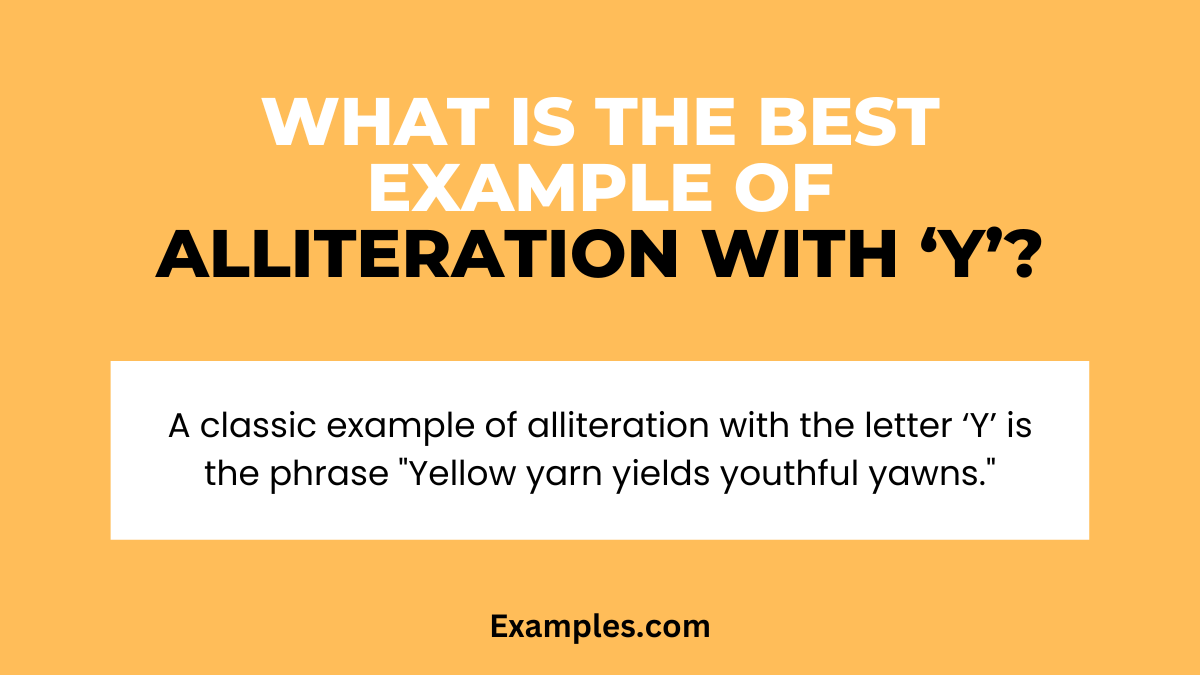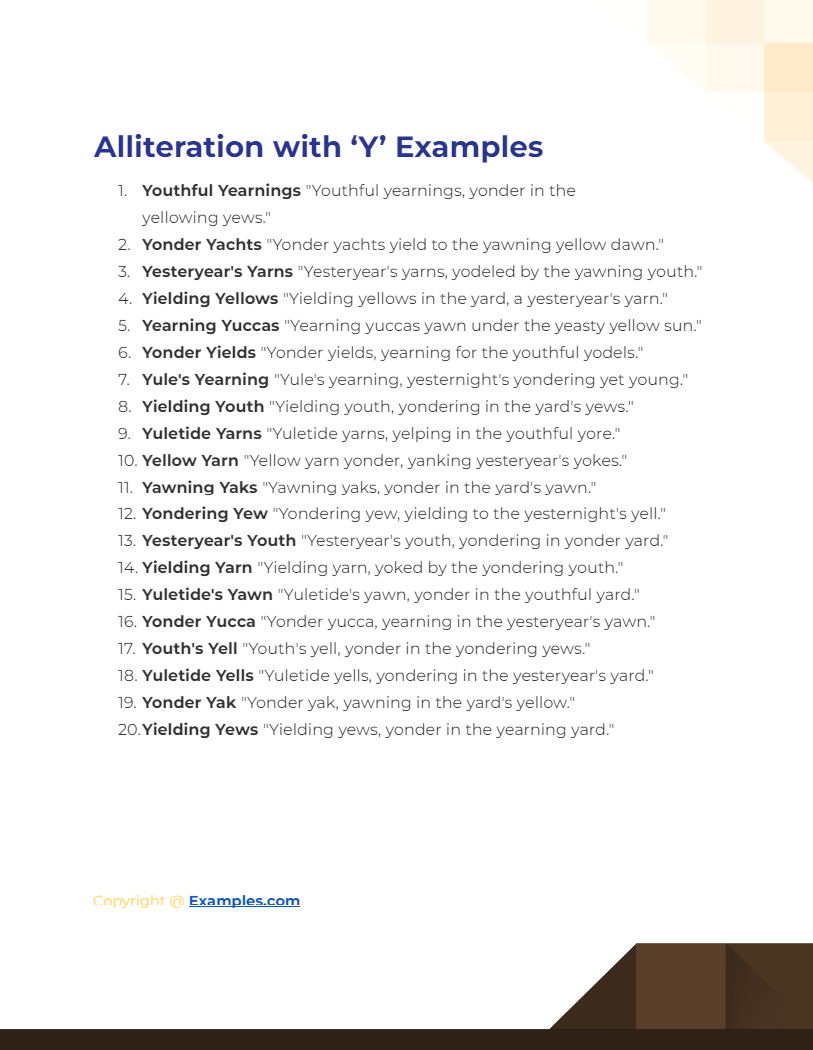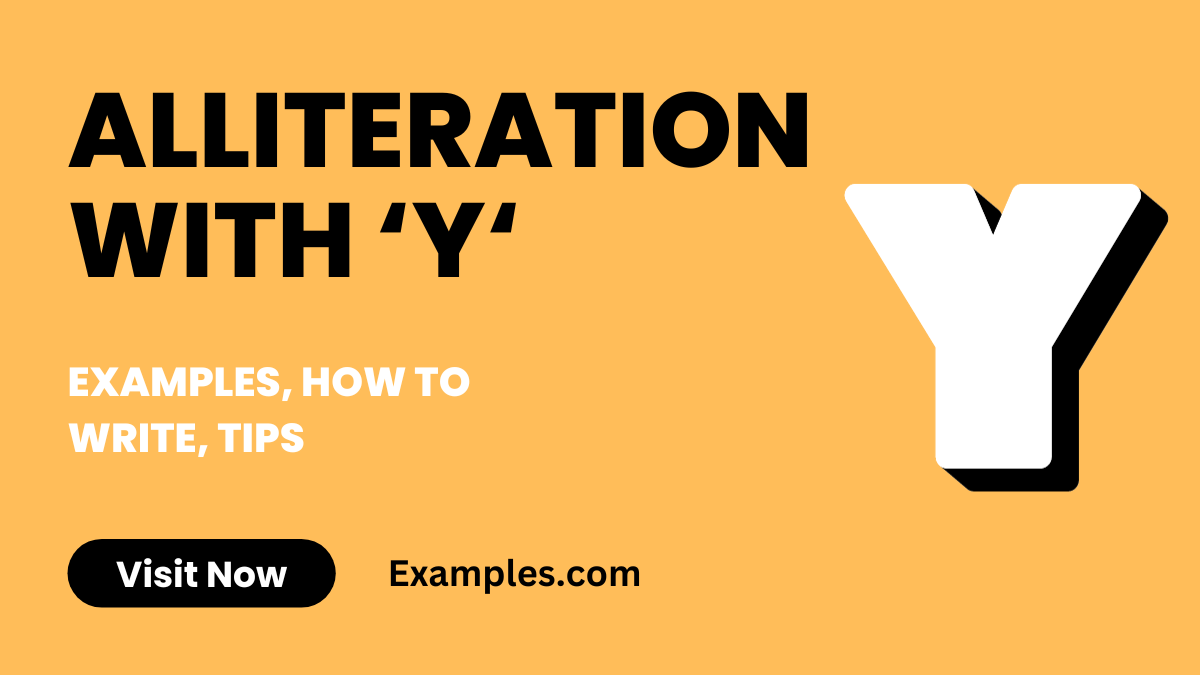Alliteration with Y
Creating alliteration with the letter ‘Y’ can add a poetic and rhythmic quality to your writing. It’s a literary device where consecutive words in a sentence or phrase start with the same sound, in this case, the ‘Y’ sound. In this article, we’ll explore the art of crafting alliteration with ‘Y,’ provide you with plenty of examples, offer tips on how to write it effectively, and show you how to incorporate it into your writing for added style and impact. Let’s dive into the world of famous alliterations!
Download Alliteration with 'Y' Examples
Download Alliteration with 'A' to 'Z' Examples
What is the Best Example of Alliteration with ‘Y’?

Example: A classic example of alliteration with the letter ‘Y’ is the phrase “Yellow yarn yields youthful yawns.”
Meaning: Alliteration is a literary device in which consecutive words in a sentence or phrase begin with the same consonant sound. In the example “Yellow yarn yields youthful yawns,” the repeated ‘Y’ sound at the beginning of each word creates a pleasing and rhythmic pattern. This technique is often used in poetry, literature, and tongue twisters to add emphasis and musicality to the text. In this specific example, the easy alliteration repetition of ‘Y’ creates a playful and memorable sentence, showcasing the beauty of alliteration in language.
20 Alliteration with ‘Y’ Examples

Download Alliteration with 'Y' Examples in PDF
Alliteration with the letter ‘Y’ yields youthful yarns of yonder and yesteryear’s yonderings, creating a lyrical and often youthful auditory experience. The ‘Y’ sound, known for its vibrancy and sometimes yearning quality, is adept at crafting hard alliteration examples. Especially effective in alliteration in rhymes, the ‘Y’ sound adds a dynamic and engaging quality to verses. Here are 20 unique examples of alliteration with ‘Y’, each accompanied by a rhyme title that encapsulates the essence of the phrase.
- Youthful Yearnings “Youthful yearnings, yonder in the yellowing yews.”
- Yonder Yachts “Yonder yachts yield to the yawning yellow dawn.”
- Yesteryear’s Yarns “Yesteryear’s yarns, yodeled by the yawning youth.”
- Yielding Yellows “Yielding yellows in the yard, a yesteryear’s yarn.”
- Yearning Yuccas “Yearning yuccas yawn under the yeasty yellow sun.”
- Yonder Yields “Yonder yields, yearning for the youthful yodels.”
- Yule’s Yearning “Yule’s yearning, yesternight’s yondering yet young.”
- Yielding Youth “Yielding youth, yondering in the yard’s yews.”
- Yuletide Yarns “Yuletide yarns, yelping in the youthful yore.”
- Yellow Yarn “Yellow yarn yonder, yanking yesteryear’s yokes.”
- Yawning Yaks “Yawning yaks, yonder in the yard’s yawn.”
- Yondering Yew “Yondering yew, yielding to the yesternight’s yell.”
- Yesteryear’s Youth “Yesteryear’s youth, yondering in yonder yard.”
- Yielding Yarn “Yielding yarn, yoked by the yondering youth.”
- Yuletide’s Yawn “Yuletide’s yawn, yonder in the youthful yard.”
- Yonder Yucca “Yonder yucca, yearning in the yesteryear’s yawn.”
- Youth’s Yell “Youth’s yell, yonder in the yondering yews.”
- Yuletide Yells “Yuletide yells, yondering in the yesteryear’s yard.”
- Yonder Yak “Yonder yak, yawning in the yard’s yellow.”
- Yielding Yews “Yielding yews, yonder in the yearning yard.”
Alliteration Sentence Examples with ‘Y’
Alliteration sentence examples with ‘Y’ often yield a youthful or yearning tone, utilizing the ‘Y’ sound to create a rhythmic and engaging narrative. This type of alliteration can be found in various literary forms, including alliteration in poems, songs, and movies, where it adds a unique charm to the storytelling. Here are three examples:
- “Yolanda’s yellow yacht yawed yarely across the yawning bay.”
- “Yanni’s yapping Yorkshire terrier yielded yelps of youthfulness.”
- “Yasmine yearned for yonder years under the yellow yarrow.”
Alliteration Examples with ‘Y’ Words
Alliteration examples using ‘Y’ words demonstrate the consonant’s ability to create vivid, memorable phrases. Often employed in alliteration in songs, the ‘Y’ sound adds a lively and engaging element. Here are three examples:
- “The yonder yard yawned with yuccas and yarrow.”
- “Yearning yodels echoed through the yawning yews.”
- “Yielding to the yearning, Yolanda yarned yellow yarns yarely.”
Alliteration Examples with ‘Y’ Name
Incorporating names that start with ‘Y’ in alliteration adds a personal and often endearing touch to phrases, making them more engaging and vivid. Here are three examples:
- “Yara’s youthful yearnings yielded a yachting yonder.”
- “Yosef’s yellow yo-yo yanked yonder, yielding yells of youth.”
- “Yasmine’s yucca yielded yellowish blooms yearly.”
Alliteration Poem with ‘Y’
An alliteration poem with ‘Y’ uses the repetitive ‘Y’ sound to create a rhythmically and aesthetically engaging poetic experience. alliteration in poems, especially with the ‘Y’ sound, brings a unique lyrical quality. Here are three examples:
- “Yonder years and yesteryears, / Youthful yells and yonder cheers.”
- “Yellow yarrow in the yard, / Yielding tales of yore, unmarred.”
- “Youth’s yearning for the yonder skies, / Yields dreams as vast as yonder lies.”
Alliteration Beginning with ‘Y’
Alliteration beginning with ‘Y’ sets a specific tone and rhythm in a phrase, often creating a memorable and impactful auditory experience. Found in various artistic expressions, including alliteration in movies, it adds a distinctive flair. Here are three examples:
- “Yolanda’s yodeling yielded yonder yearnings.”
- “Yawning yonder, the yellow yard yawned at dawn.”
- “Yosef yearned for yesteryear’s yachting yonder.”
How to Write Alliteration with ‘Y’?
Creating alliteration with the letter ‘Y’ involves the clever use of words that start with the ‘Y’ sound, placed in close proximity within sentences or phrases. The ‘Y’ sound, known for its youthful and sometimes yearning quality, can add a lively rhythm and unique tone to your writing. This technique is utilized across various contexts, from educational content like alliteration for first grade to more nuanced alliteration in figurative language. Here’s how to craft effective alliteration with ‘Y’:
- Understand the ‘Y’ Sound: Familiarize yourself with the ‘Y’ sound. It’s a consonant that can bring energy and a playful quality to your writing.
- Select a Theme or Concept: Choose a theme or subject. This aids in finding relevant ‘Y’ words that suit your topic, whether you’re crafting alliteration with answers or for creative expression.
- Brainstorm ‘Y’ Words: Compile a list of words that start with ‘Y’. Include a variety of words (nouns, verbs, adjectives) to enrich your alliteration.
- Create Your Phrase or Sentence: Form a sentence or phrase using your chosen ‘Y’ words. Strive for a natural flow that accentuates the alliterative effect.
- Read Aloud for Rhythm: The effectiveness of alliteration is often best judged audibly. Read your sentence aloud to ensure it has a pleasing rhythm.
- Revise for Clarity and Impact: Ensure your alliterative phrase is clear and contributes effectively to your overall message or story.
- Apply in Various Contexts: Adapt your use of ‘Y’ alliteration for different purposes and audiences, whether in alliteration figurative language exercises, as part of teaching alliteration for first grade, or in creative writing.
Tips for Using Alliteration with ‘Y’
Here are the Tips for Using Alliteration with ‘Y’:
- Use Sparingly: While ‘Y’ alliteration can be engaging, overusing it can overwhelm your text. Use it to emphasize key points or add stylistic flair but in moderation.
- Maintain Clarity: Your primary goal is to convey a message clearly. Alliteration should not overshadow your narrative but complement it.
- Vary Word Length and Complexity: Mix short and long ‘Y’ words, as well as simple and complex ones, for a more dynamic textual rhythm. This is particularly important in alliteration for first grade, where simpler language is essential.
- Consider the Mood: The ‘Y’ sound can be playful and light. Use it in contexts where this mood is fitting.
- Read and Revise: Reading your work aloud helps you assess the rhythm and flow. Adjust as needed to ensure the alliteration enhances the text.
- Appropriate for Audience: Tailor your alliteration to your audience. For instance, alliteration for first grade should be simpler and more playful than alliteration for adults.
- Explore Different Forms: Experiment with ‘Y’ alliteration in various forms of writing, from poetry and stories to advertising and academic work, to understand its effect.
The key to effective alliteration with ‘Y’ is balancing its unique sound with readability, ensuring that the alliterative phrases enhance your writing.
What is the Alliteration with ‘Y’ for Kindergarten?
Alliteration with ‘Y’ for kindergarten involves creating simple, catchy phrases using words that start with the ‘Y’ sound. This form of alliteration is excellent for early language development, helping young learners with phonetic awareness and introducing them to the fun aspects of language. These alliterative literature are crafted to be easy for kindergarten students to understand, repeat, and enjoy. Examples include:
- “Yoyo the yellow yak yawned in the yard.”
- “Yolanda’s yellow yarn yielded a yappy Yorkie.”
- “Yummy yellow yogurt was Yanni’s favorite.”
These alliteration examples are designed to be engaging and educational, fostering a love for language and learning in young children.
What are the Alliteration with ‘Y’ for Kids?
Alliteration with ‘Y’ for kids involves creating fun and memorable phrases that utilize the ‘Y’ sound. This form of alliteration is great for language development, helping children to learn about sounds and vocabulary in an enjoyable way. Here are three examples tailored for alliteration for kids:
- “Yara and Yasmine played with yellow yo-yos.”
- “Yanni’s young yak yearned for yummy yams.”
- “Yelling yaks yodeled in the yard yesterday.”
These examples are created to be simple and engaging, making them suitable for children’s language learning and entertainment.
What is the Effect of ‘Y’ Letter in Alliteration?
The effect of the ‘Y’ letter in alliteration is to create a youthful, sometimes yearning sound that adds a playful and engaging quality to language. The ‘Y’ sound, being a semi-vowel, has a unique quality that can make phrases more memorable and appealing. In literature, ‘Y’ alliteration is often used to add rhythm, set a specific mood, or emphasize certain parts of the text. It is versatile and can be used effectively in alliteration for kids, where it adds a playful and light-hearted tone, as well as in more sophisticated literary works for adults. The ‘Y’ sound is also significant in alliteration and assonance, contributing to the overall sonic appeal of a piece.
What is the Alliteration ‘Y’ Type of?
Alliteration with the letter ‘Y’ is a type of consonantal alliteration, where the consonant sound at the beginning of adjacent or closely connected words is repeated. This type of alliteration is common and effective in various forms of writing, from creative poetry to prose. The ‘Y’ type of alliteration can create different effects, from playful and light-hearted to more lyrical and evocative, depending on the context and the words chosen. This form of alliteration is seen in a wide range of literary contexts and is particularly effective in educational materials for its engaging appeal, widely used in alliteration for students and alliteration for kids. The ‘Y’ alliteration’s ability to add a rhythmic and enjoyable quality to writing makes it a valuable tool for writers and educators alike.


